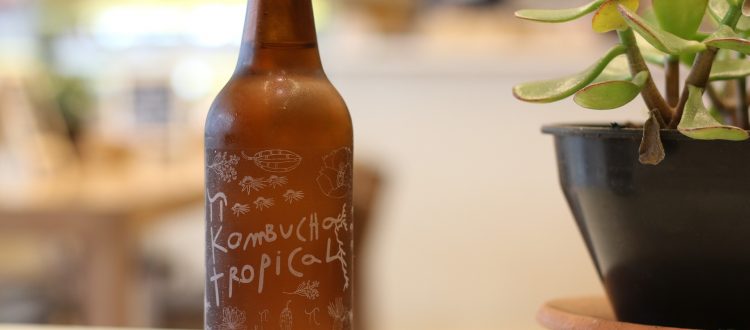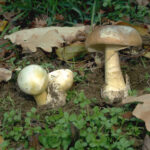
Kombucha tea has a long history of use in China and Japan and is now popular throughout the world. It is prepared by fermenting sweetened tea. Because of its purported health benefits and perceived simplicity of production, it has become popular to do this fermentation in the home. However, this is not without hazards which are greater in home fermented than when fermented commercially because of the stricter control of the fermentation in a factory setting. In spite of its long history of use, there have been occasional illnesses from chemical components of the tea.
The fermentation is carried out by a cooperative culture consisting of bacteria and yeast. This is described as a tea fungus, matt, mother or SCOBY, depending on the recipe you read.
The flavour is due to the action of the SCOBY and since SCOBYs vary in their composition i.e. the number and types of yeasts and bacteria present, every SCOBY produces kombucha with a different composition. The type of tea used, the amount of sugar added and the time of fermentation will also affect the flavour and composition.
In simple terms, the yeasts break the sugar down into glucose and fructose and then convert the glucose to carbon dioxide and alcohol. The bacteria break down some of the alcohol and produce a large range of other chemicals during the fermentation, including a range of acids, and some of these chemicals may, in rare cases, produce unwanted side effects in individuals.
There may be a significant amount of alcohol remaining in the final tea, particularly if fruit is added.
Safe fermentation conditions
- Make sure all the equipment you use is scrupulously clean, preferably washed in a dishwasher.
- Water is boiled and sugar is added and dissolved.
- The fermentation vessel should be made of food-grade glass or stainless steel. Plastics, lead crystal and ceramics are not recommended as components may leach into the kombucha during the fermentation.
- Green or oolong-based tea is not recommended because there is more acid produced which can lead to problems
- The selected black tea is then infused into the liquid for the required time.
- The tea is allowed to cool to around 20-25 deg C within 2 hours. Ideally, this should be measured by a thermometer and the time checked. If the tea is too hot the SCOBY may die, if too cold the fermentation may not start correctly. In both instances the acid, which keeps the tea safe from the growth of spoilage and food poisoning microbes, will not be produced fast enough. The tea should be covered at this stage to avoid contamination from the air.
- The SCOBY or culture from a previous fermentation is then added. Before addition this should be examined for any discolouration or abnormal odour which might mean that moulds or unwanted bacteria are present. Any SCOBY with green, white, black or grey discolouration or an off-odour should be discarded. Ideally you should measure the pH of the starting liquid using a pH meter or pH strips just like you would measure the pH of your swimming pool water.
- The vessel should be covered with a cloth or a lid with a release valve to let the gas produced escape to prevent contamination.
- To ensure that the fermentation proceeds as it should, it must be carried out at a temperature between 18-26 deg C. If the temperature is too low the fermentation will be slow or not start and if too high the desired bacteria will not grow. A drop in pH after day 1 will tell you that the fermentation is proceeding properly.
- Fermentation time should be about 7 days. If the time is too short there may not be sufficient acid produced to make the product safe. On day 7 the pH of the tea should be measured and it should be down to below 3.0 at the end of fermentation. If it is not at pH of 3.0 at the end of 7 days, continue the fermentation, measuring the pH each day. If it has not reached a pH of less than 3.0 by the end of 10 days it is strongly recommended that you discard the batch.
- Remove the culture and bottle or refrigerate the tea until it is at or below 5 deg. C.
- If fermented under the correct conditions with a healthy SCOBY to a pH at or below 3.0 the unpasteurised tea can be kept in the refrigerator until it shows signs of spoilage, especially look out for signs of mould growth or extra cloudiness in the tea.
- It is recommended that no more than 125 mL or ½ cup is consumed per day(Greenwalt, 2000).
Chemical hazards
- As with any food or beverage, too much kombucha tea can cause problems in sensitive individuals such as those who are immune compromised, pregnant women, those with a history of heavy drinking, those with allergies and those sensitive to FODMAPS. By-products produced by the SCOBY include ethyl carbamate, biogenic amines, various acids and alcohol which can all produce illness if they are consumed at excessive levels or by sensitive individuals.
- The acid content of kombucha tea is very high and if too much is consumed acidosis (too much acid in the body fluids) can result in sensitive individuals and this can be life threatening. Therefore there is a limit to the recommended daily intake of 125 mL for healthy individuals. The tea should only be fermented from black tea not green tea to avoid extra high levels of acid present.
- Daily consumption of kombucha at higher levels has produced illness in some susceptible individuals including hyperthermia, renal failure, toxic hepatitis, pain, allergic reactions, yellowing of the skin, discoloured stool and urine, anxiety and nausea. The range of symptoms is very widespread due to the different compositions of the teas and susceptibility of the patients. There has been a report of a person suffering from lead contamination because the tea was brewed in a ceramic pot.
- Kombucha may also affect blood sugar levels so diabetics need to be aware of this.
- Anyone with a kidney disorder should follow the kombucha tea with a drink of water to help excrete the acid.
- Allowing time for a second fermentation to occur or the adding fruit for flavour can lead to excessive alcohol production by the yeast. To prevent this the second fermentation should be limited to 7-10 days and preferably the tea should be pasteurised, i.e. heated to 83 deg. C or hotter and filled into clean glass bottles, sealed immediately and laid on their sides to pasteurise the lid for 3 minutes. This will stop fermentation, prevent leakage and prevent spoilage.
Microbial hazards
- Tea is a natural product and may already be contaminated with food poisoning bacteria or spores that can grow in very warm conditions. If the infused tea takes more than 2 hours to cool because it is in a very large container, these spores can germinate and bacteria can grow. So divide large amounts, 5 L or more, into smaller containers to ensure the tea cools within the required time.
- The fermentation must produce sufficient acid to take the pH down to below 3.0 to prevent the growth of food poisoning bacteria. To ensure that the fermentation has proceeded correctly the person fermenting the tea must at least be able to measure the pH of the final tea. If the pH is above 3.0 the kombucha may not be safe to drink.
- Moulds are another hazard. They can come from the SCOBY or reused kombucha culture or the air during cooling and fermentation. The most common moulds found in kombucha tea are Aspergillus and Penicillium. Not only can these moulds produce toxins as they grow, they also use up the acid and raise the pH to levels where any food poisoning bacteria present can grow.
- The presence of anthrax Bacillus has been reported in kombucha tea fermented in unhygienic conditions so it is important to maintain cleanliness of the environment, any utensils used and storage containers.
Find out more about other fermented foods



